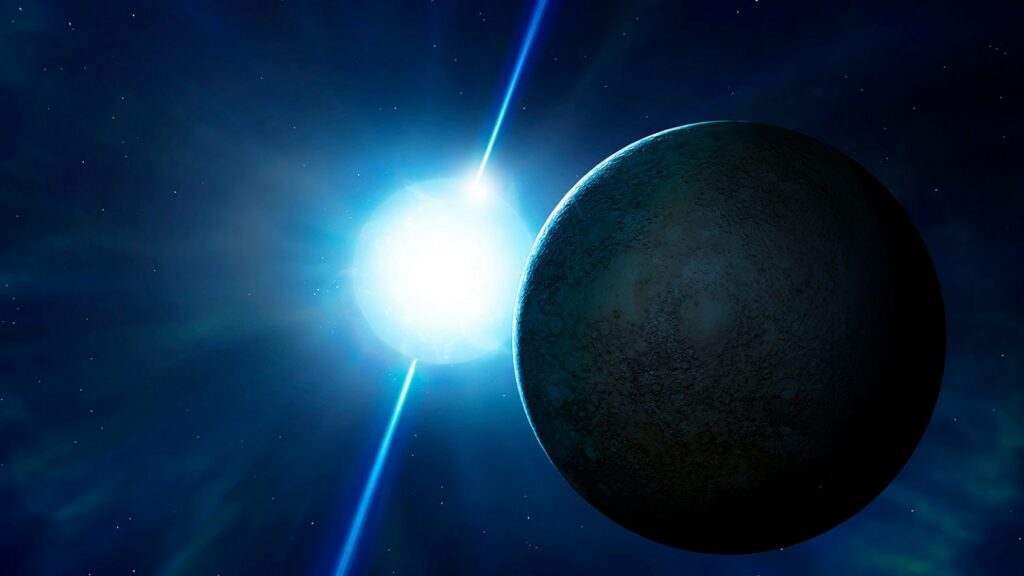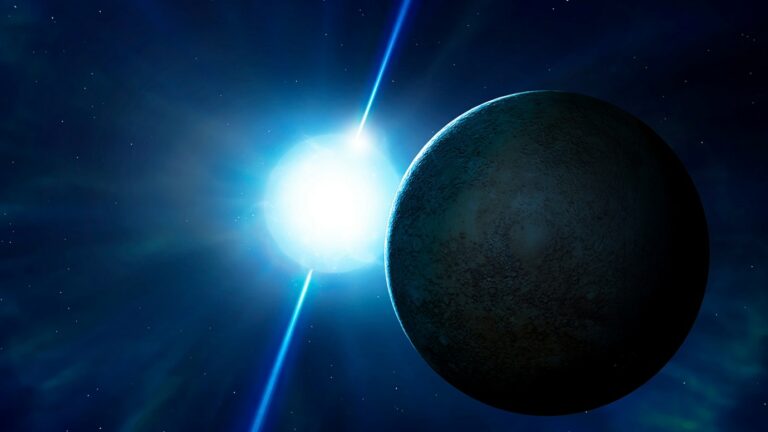Repetitive Fast Radio Bursts Potentially Instigated by Disintegrating Planets
It is an additional hypothesis amidst numerous others regarding the origin of these flares.
Astronomical phenomena known as fast radio bursts (FRBs) have been a subject of intense study in recent years. These bursts, which last only milliseconds, originate from distant cosmic locations and can either occur once or repeat multiple times. In a recent study published in the March 20 Astrophysical Journal, researchers propose a new explanation for the repetitive FRBs, suggesting that they may be caused by planets coming into close proximity with their magnetic host stars.

MARK GARLICK/SCIENCE PHOTO LIBRARY/GETTY
Since the discovery of the first FRB in 2007, scientists have observed numerous instances of these mysterious radio bursts. Various theories have been put forth to explain the different types of FRBs, with most involving compact, magnetic remnants of stars called neutron stars. Some hypotheses propose that the bursts are the result of powerful radio flares emitted by magnetars, which are the most magnetically intense neutron stars known to exist. Others suggest that fast-spinning neutron stars or interactions between asteroids and magnetars could be responsible for the bursts.
However, the new computer calculation presented in this study introduces the idea that planets orbiting closely around their magnetic host stars could be the cause of the repetitive FRBs. This hypothesis adds another dimension to our understanding of these enigmatic cosmic phenomena and opens up new avenues for further research and investigation.
The production of fast radio bursts is still a topic of debate, according to astronomer Yong-Feng Huang from Nanjing University in China.
Huang and his colleagues have proposed a new mechanism for generating these repeating bursts: the interaction between a neutron star and an orbiting planet. They investigated the possibility of planets coming very close to these stars, and calculated the effects of a highly elliptical orbit around a neutron star. As the planet approaches its star closely, the star’s gravity exerts a stronger pull on the planet, causing it to elongate and distort. Huang refers to this phenomenon as a “tidal pull,” which results in the formation of small clumps being ripped off the planet. These clumps, according to the team’s calculations, are only a few kilometers wide and have a mass that is one-millionth of the planet’s mass.
This is when the fireworks begin. Neutron stars emit a wind of radiation and particles, similar to our own sun but on a more extreme scale. When one of these clumps passes through the stellar wind, the interaction can generate powerful radio emissions. If this occurs while the clump is in front of the star from Earth’s perspective, it could be observed as a fast radio burst. Huang explains that each burst in a repeating signal of fast radio bursts could be attributed to one of these clumps interacting with the neutron star’s wind during each close pass of the planet. After the interaction, the remnants of the clump continue to orbit the star, but from Earth’s perspective, they move away and are no longer visible.
By comparing their calculated bursts with two known repeaters, including the first ever discovered repeater that repeats approximately every 160 days, and a more recent discovery that repeats every 16 days, the team found that the scenario of a fragmenting planet could account for the frequency and brightness of the bursts.
Astrophysicist Wenbin Lu from Princeton University, who investigates potential FRB scenarios, suggests that the strong gravitational pull exerted by the star on the planet during each close pass could gradually alter the planet’s orbit. This phenomenon leads to a rapid shrinking of the orbit due to tidal interactions between the planet and the star, resulting in energy loss from the system. Consequently, there is a possibility that the orbit could shrink so rapidly that FRB signals would not persist long enough for detection. However, this change in orbit could also serve as a means for astronomers to investigate the FRB source. By observing repeating FRBs over several years and monitoring any variations in the time intervals between bursts, scientists can determine whether this hypothesis aligns with the observed data. Lu suggests that this approach could provide valuable insights into the nature of FRBs.
Do not forget to share your opinion with us to provide you with the best posts !




0 Comments